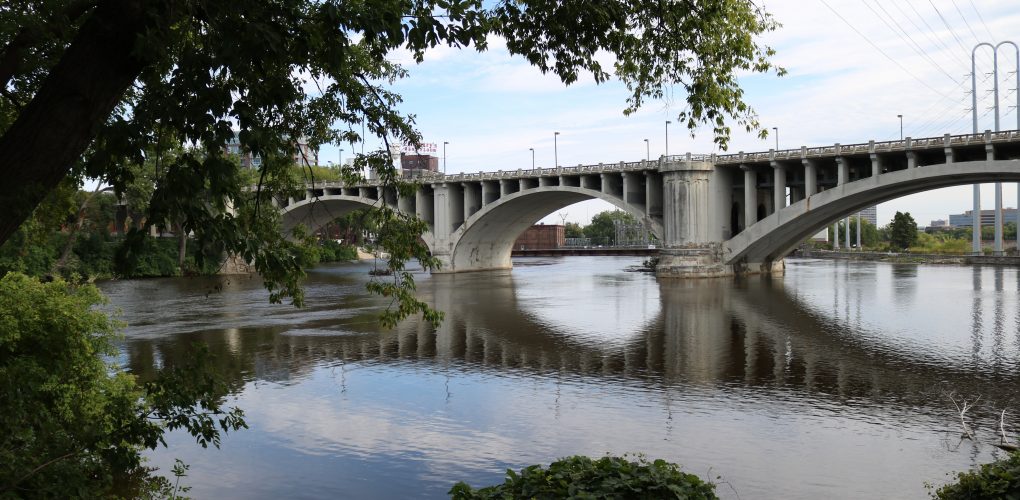Bridge engineers overcome a seemingly impossible challenge on a rehab project.
Have you ever faced a bridge engineering challenge you thought was impossible to overcome? Check out the one the team rebuilding the Third Avenue Bridge in Minneapolis had to deal with. They used creativity and cutting-edge technology deployed in a novel way to win out over the forces of nature and a structure that seemed impossible to access and work on.
The issues faced by the Third Avenue Bridge rehabilitation team.
The Third Avenue Bridge is a major connector between downtown Minneapolis and the northeast section of the city, a vibrant neighborhood locally referred to as “Nordeast”. In recent years, the structure was in desperate need of rehabilitation. The work had been delayed for a long time because the project promised to be a challenging one. That’s because the viaduct is located in a difficult spot over Mississippi River rapids, has a unique design, was built using unconventional materials and is historically significant.
The Third Avenue Bridge was completed and opened more than one hundred years ago, in June 1918. It’s unusual “S” shape design was necessitated by its position just above the rapids leading into the St. Anthony Falls. It was the only way its foundation could be built in the rushing water at the time it was developed.
The bridge features concrete arches that surround a steel skeleton. The old Milan-style arch construction used on this bridge has since been retired and replaced by more modern and durable rebar-reinforced concrete methods. The viaduct has many historic elements, including its decorative railing. It’s located in a historic area with cobblestone streets and sensitive parkland, which adds to the construction challenges. It’s difficult for large trucks and cranes to reach the site without causing damage.
Because of these issues, engineers had to explore novel options for placing equipment on the structure. This was a real-world case of necessity becoming the mother of invention. When all-terrain, crawler, barge-mounted or bridge cranes were not a possibility, the team turned to an innovative option used in a unique way: tower cranes built into the original bridge structure.
The solution the engineers came up with.
Engineers originally thought about using tower cranes because they wouldn’t add any load to the bridge deck, which was in poor condition. Another plus is that the original large box columns supporting the structure were still strong. That encouraged them to explore the idea of mounting the tower cranes to the columns. They had concerns about the capacity and reach of the tower cranes, which they studied in great detail using computer modeling techniques.
They found that standard tower crane attachments were too big for the space available to mount them. The construction team came up with an original solution to the problem. They used the existing bridge piers as anchors, embedded the tower section of the crane in the box column, reinforced it with concrete and then bolted on the rest of the tower crane as they normally would. In short, the tower crane actually became a part of the bridge structure during the rehabilitation process. This complex solution involved everyone on the design, engineering and development team to pull it off. Complex 3D software was used to model the solution and to plan how it could be implemented.
In the end, the tower cranes will not damage the piers, and they will be able to be returned to their original state once construction is over. However, there will be one major change. The tower portion of the cranes that’s embedded in the box columns will remain parts of the structure for as long as it lasts. Three tower cranes have been used on the site since January and a fourth one will be added later in the summer.
The tower cranes weren’t the only solution used on the job site. Once the bridge was strengthened and stabilized, rough terrain cranes and lifts like those offered by Bridge Masters were introduced into the construction process to get to hard-to-reach bridge areas and complete more sensitive tasks.
The ultimate scope of the project and completion date.
In the end, work on the project will include replacing the bridge deck, putting in new lighting, spandrels and pilasters and fixing the piers and historic railing. An addition is new bicycle and pedestrian paths that are separate from vehicle lanes.
Work on the Third Avenue Bridge is expected to be complete in November 2022 and should extend the usable life of the bridge by another 50 years. Many believe that the innovative embedded tower crane solution invented for the project will be used on rehabilitation projects for other historic bridges.

